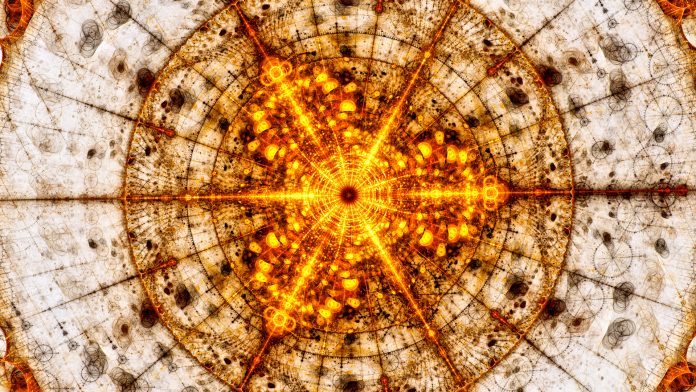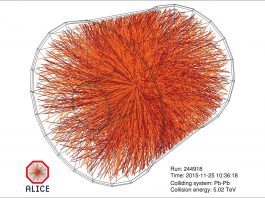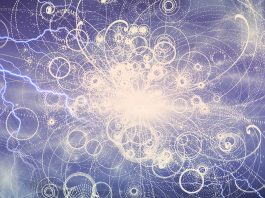Yale University’s Professor John W Harris and Brookhaven National Laboratory’s Dr Thomas Ullrich outline the science case for the Electron-Ion Collider and what it is expected to achieve.
Quantum Chromodynamics (QCD) is the fundamental quantum theory of quarks and gluons that make up nearly all the visible matter in the universe. Quarks interact by exchanging gluons, but gluons also interact with gluons, a unique feature of QCD. Despite being so central to QCD, the properties and dynamics of gluons remain largely unexplored. The inspiration to solve the profound mysteries surrounding this ‘glue’ drives the development of a next-generation facility, the Electron-Ion Collider (EIC).
The Electron-Ion Collider, which is being built at Brookhaven Laboratory in the USA, will reveal the secrets of QCD and how these quarks and gluons generate the properties of particles, such as their mass and spin. It will unveil whether gluons in the atomic nucleus, when inspected at very high energies or magnification, appear as an extremely dense system with universal properties. The EIC will also investigate the process of how quarks and gluons, which are never observed as single free entities, when liberated from particles or nuclear matter form new particles known as hadrons.1 The EIC will enable the next big step in understanding the fundamental constituents of matter.
The classic description of the proton, seen in Fig. 1 (left), is that it consists of three quarks held together by gluons. This is an oversimplification.2 All particles and anti-particles, including quarks and gluons, can be real or virtual and pop in and out of existence. This has been observed in experiments. A view of the nucleon (proton or neutron) with the extreme ‘magnification’ that will be provided by high energy collisions at the Electron-Ion Collider is presented in Fig. 1 (right).
Science of the Electron-Ion Collider
The Electron-Ion Collider will address some of the major challenges facing modern science today and has profound links to forefront research in other subfields of physics. It focuses on one of the most puzzling of all fundamental particles, the gluon. Without gluons, matter would not exist. Gluons keep quarks bound in nucleons (protons and neutrons) in the atomic nucleus, enabling the existence of atoms. In QCD, gluons collectively carry the strong nuclear force that acts on a quark’s ‘colour’ charge, analogous to photons that act on a particle’s electric charge creating the electromagnetic force. But unlike photons, which are electrically neutral, gluons carry their own colour charge, which means they can interact among themselves, and even multiply, through the strong interaction as well as with quarks. It is this self-interaction that makes QCD such a fascinating yet complex theory. Despite their importance, little is known about gluons and the many-body quark-gluon dynamics they create. Current experimental results and theoretical descriptions suggest that both nucleons and nuclei, when viewed at high energies, appear as a dense system of gluons whose number grows rapidly with energy. The laws of physics dictate that this ever-growing gluon density must eventually saturate, a regime known as the colour glass condensate (CGC). Underlying theories suggest that in the realm of a CGC all matter should have the same appearance, forming a truly universal gluonic regime.
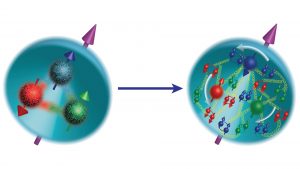
Understanding the properties and origin of matter demands that we develop significantly more and deeper knowledge of the emergent dynamics of these gluonic interactions in QCD. The following three sets of questions are among the most intellectually pressing that will be addressed by the Electron-Ion Collider:
- How are the quarks and gluons, and their spins, distributed in space and momentum inside the proton? How are these distributions connected with the overall properties of the proton such as mass and spin?
- Is there a regime in the nucleus where, when viewed at high energies, the density of gluons starts to saturate? What are the emergent properties of dense systems of gluons? Does gluon saturation produce matter with universal properties in the nucleon and in nuclei when viewed at very near the speed of light?
- What governs the transition from quarks and gluons to hadrons? Can a better understanding of this dynamical conversion (known as hadronisation) shed light on the mystery of confinement – the phenomenon that color charged particles such as quarks cannot be observed in isolation?
Deep-Inelastic Scattering (DIS)
The Electron-Ion Colliderwill investigate protons and nuclei by colliding electrons and ions4 with unprecedented precision and explore new regimes of strongly interacting matter. It will do so by employing a process known as Deep-Inelastic Scattering (DIS), illustrated in Fig 2. A high-energy electron that passes through a proton or nucleus will interact via the electromagnetic force with individual electrically charged quarks that carry a fraction x of the momentum of the proton (or nucleus). The electron transfers a quantity called Q2, which is the square of the momentum transferred to the quark. The variables x and Q2 as shown in Fig. 2 are important parameters in these processes and are determined completely by measuring the momentum and direction of the scattered electron. Q2 is a measure of the resolution power; the higher Q2 the smaller the features of the proton that can be studied. Since the interaction of the electron and quark is precisely understood in electromagnetism, the presence of gluons will modify this interaction in ways that will help determine the properties and interactions of the gluon. In particular, hadronic matter at low-x is a regime of special importance for the EIC as it is dominated by gluons. Studies of DIS processes at the EIC will greatly expand our knowledge and understanding of QCD and the unique role of the gluon.3, 5
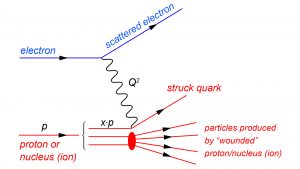
While answers to these questions are the main motivation for the EIC, there are many other compelling science questions that can be addressed. Examples are the various opportunities for electroweak (EW) and beyond the Standard Model (BSM) physics. Measurements at the EIC are also expected to deliver important input for understanding reactions in several areas of astro-particle physics, such as cosmic-ray air showers and neutrino astrophysics. Furthermore, Electron-Ion Collider studies of nuclei can provide important information on what are the initial conditions and the possibility of gluon saturation in heavy-ion collisions that lead to the creation of the quark-gluon-plasma. Although the EIC is a high-energy collider, there are key measurements that are of relevance also to nuclear structure physics at much lower energies.
Physics requirements
For the EIC to accomplish its physics mission and answer the challenging questions above it must provide a range of centre-of-mass energies and reach sufficient energy to access the gluon-dominated physics regime. This requires a versatile complex of accelerators and a collider with the following characteristics.
- In order to study the spin structure and three-dimensional spatial and momentum structure of protons, polarised electron and proton (and light ion beams) are necessary. Extraction of the spatial structure of the proton demands large statistics and requires a collider with high luminosity, far exceeding by two orders of magnitude the intensity of the former electron-proton collider HERA at DESY in Germany;
- The search and study of gluon saturation is best conducted in heavy, dense nuclei where the gluon density is highest. This requires electron collisions with beams with masses of those up to the heaviest of nuclei;
- To determine the effect of the nuclear environment on quarks and gluons, how a fast-moving quark or gluon affects nuclear matter, and how they form hadrons (hadronisation) requires a complex set of detectors to reconstruct the complete final state of the collision. This includes their energy, direction, and mass of all products of the reaction.
Electron-Ion Collider design
The conceptual design of the EIC has been documented and has the following main parameters: (i) highly polarised electron and proton beams each with ~70% polarization; (ii) ion beams from deuterons to lead or uranium; (iii) variable electron+proton centre-of-mass energies from 20-140 GeV; (iv) high electron-nucleon luminosity 1033-1034 cm-2 s-1; and (v) the possibility of providing collisions to two experiments at the same time.
These performance parameters will be realised for the first time in a collider. With the energies provided by the EIC one will be able to resolve scales of 1/1000th the radius of a proton. The EIC will utilise one of the present RHIC superconducting accelerator rings of 3,834m length, a new electron storage ring with a similar circumference in the same tunnel, and an injector ring for on-energy injection of polarised electron bunches. A schematic of the design is provided in Fig. 3.
Detectors at the EIC
Large and complex detector systems are required to record the collisions of electrons with protons or nuclei at the EIC. These will identify specific reactions whose precise measurement can yield previously inaccessible insight into the structure of the nucleon and nucleus, and the role of gluons. Achieving the EIC physics goals will be a challenging endeavour that places unique demands on the collider and the detector systems. The requirements for the detectors vary in each of the different detection regions seen in Fig. 4. This is especially critical along the beampipes, which require specialised instrumentation due to the increased particle flux there. The requirements for the detector systems are documented in a recent detailed study.
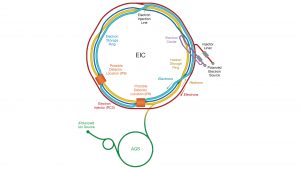
The most important requirements of the large detectors are: (i) an almost 4𝜋 hermetic coverage for the measurement of electrons, photons and hadrons; (ii) low-mass tracking detectors in a strong magnetic field that do not interfere with the energy and path of the scattered electron; (iii) excellent momentum resolution in the central detector; (iv) good momentum resolutions in the forward (hadron endcap) and backward region (electron endcap); (v) excellent pointing precision around the interaction point to identify short-lived decays of heavy quarks; and (vi) measurement of the particles’ energy over the entire range with the strongest constraint being in the electron-going direction.
A crucial requirement, that also makes the EIC detector unique is the need to identify t
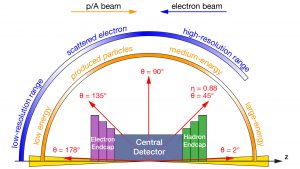
he type of particles created in backward, central, and forward regions over a wide range of momenta. This identification is commonly achieved by measuring the particle’s velocity with either precise timing detectors, with resolutions of the order of tenths of picoseconds, or gaseous detectors that make use of the light from the Cherenkov effect. A particle’s velocity together with the knowledge of its momentum provides the mass of the particle – a unique identifier.
Efforts are currently underway to design detectors that meet all the requirements and allow exploitation of the rich physics program of the EIC. The detectors will be large, complex, and unique. They will employ sophisticated instrumentation to be designed and constructed by scientific collaborations with hundreds of scientists, engineers, and technicians from laboratories and universities worldwide, and with the help of industry.
EIC timescale and future
The EIC was established as the highest priority for new construction in the 2015 US Nuclear Physics Long Range Plan and was endorsed favourably by the US National Academy of Sciences in their 2018 US NAS Report. In December 2019, the EIC passed the first of many critical steps defined by the US Department of Energy, which launched the EIC as an official project. The EIC project schedule foresees completion with the start of data taking in 2030.
The EIC will map the correlated locations, motions, and spins of gluons and quarks within protons and neutrons. These multi-dimensional ‘images’ will help theorists calculate the contributions that quarks and gluons make to their parent particle properties and will provide unprecedented insight into the quark and gluon dynamics in QCD that bind protons and neutrons together. It will search for a new, possibly universal, regime of nuclear matter where gluon densities are saturated and colour fields may be the strongest fields allowed in nature.
Acknowledgements
This work was supported by the Office of Nuclear Physics in the Office of Science of the U.S. Department of Energy.
References
- Hadrons are particles that interact via the strong interaction described by QCD. The two classes of hadrons are baryons, particles that contain three quarks such as the proton and neutron, and mesons that contain a quark and an anti-quark
- Experiments at HERA at the DESY Laboratory in Germany found the proton to be a complex interplay of quarks and gluons, which were not static nor fixed in numbers at any instant in time
- Electron-Ion Collider: The next QCD frontier: Understanding the glue that binds us all, A. Accardi et al., Eur. Phys. J. A (2016) 52:268. https://link.springer.com/content/pdf/10.1140/epja/i2016-16268-9.pdf
- Nuclei with a net electric charge, necessary for use in particle acceleration
- An Assessment of U.S.-Based Electron-Ion Collider Science, National Academy of Sciences https://www.nap.edu/catalog/25171/an-assessment-of-us-based-electron-ion-collider-science
Please note, this article will also appear in the sixth edition of our quarterly publication.

